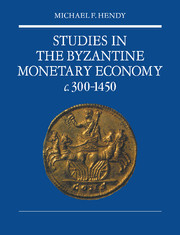Book contents
- Frontmatter
- Contents
- List of plates
- List of maps
- List of tables
- Abbreviations
- Preface and acknowledgements
- Introduction
- SECTION I ECONOMY AND SOCIETY
- SECTION II FINANCE
- SECTION III COINAGE (CIRCULATION)
- SECTION IV COINAGE (PRODUCTION)
- 7 Administrative basis
- 8 History
- Preliminary observations, future directions
- Bibliographies
- Key to plates
- Indexes
- Plate section
8 - History
Published online by Cambridge University Press: 05 November 2011
- Frontmatter
- Contents
- List of plates
- List of maps
- List of tables
- Abbreviations
- Preface and acknowledgements
- Introduction
- SECTION I ECONOMY AND SOCIETY
- SECTION II FINANCE
- SECTION III COINAGE (CIRCULATION)
- SECTION IV COINAGE (PRODUCTION)
- 7 Administrative basis
- 8 History
- Preliminary observations, future directions
- Bibliographies
- Key to plates
- Indexes
- Plate section
Summary
PROLEGOMENON
The monetary chaos that had marked the sole reign of Gallienus (260–8) and his immediate successors had been barely, if at all, alleviated by the modest measures of Aurelian (270–5) when Diocletian became emperor in 284. The standard components of the monetary system, the denarius which bore a laureate imperial portrait, and its inflationary and increasingly predominant double which is now generally termed the antoninianus and which bore a radiate portrait, survived the first half of the third century as coins of diminished but still easily recognisable silver content at about 45 %. This content probably weakened further – perhaps to the region of 15 % – by or during the joint reign of Valerian and Gallienus (253–60), but it was only during the sole reign of the latter that it collapsed to a mere 1 %–2 % or so. Both denominations meanwhile lost an appreciable proportion of their weight. The debasement and general depreciation of the silver coinage was accompanied, as might be expected, by a sharp increase in the amount issued: the total of officinae in established mints rose and new mints were created, flooding the empire with virtually worthless coin. This combination ensured the discontinuation of the subsidiary coinage of sestertii, dupondii, asses and semisses, in bronze and copper, when its issue at an intrinsic value equal or superior to that of the debased standard coinage was simply rendered uneconomic. The gold coinage, which had provided high-value multiples of the denarius, remained undebased and for that reason seems to have come to command a considerable premium.
- Type
- Chapter
- Information
- Studies in the Byzantine Monetary Economy c.300–1450 , pp. 448 - 552Publisher: Cambridge University PressPrint publication year: 1985



